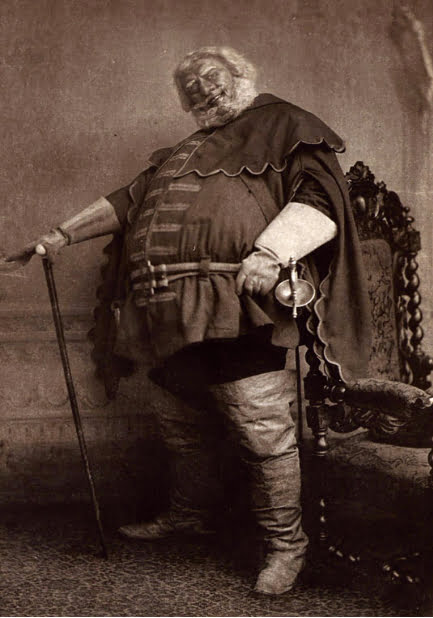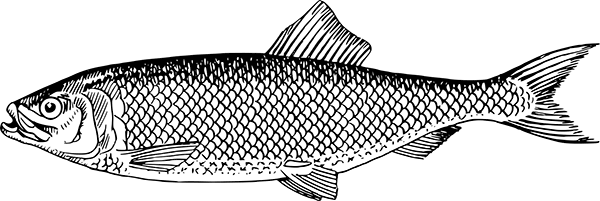On the connection between Sir John Fastolf, victor at the Battle of Herrings, and Sir John Falstaff, a large Shakespearean character
BATTLE OF THE HERRINGS (1429)
There are two jokes at the heart of Shakespeare’s Henry IV part 1. One is fairly straightforward, the other is quite complex and involves The Battle of the Herrings which took place in 1429. The astute amongst you will say, But Henry IV parts 1 & 2 must take place before 1429, because Henry V takes place before and after the Battle of Agincourt, which was in 1415. Shakespeare, however, is playing fast and loose with his dates, just so he can make these gags. There is considerably more on all of this in herripedia entry, Red Herring Joke, The.
The jokes are both rooted in the name he gives to Prince Hal’s fat rogue of a companion, Falstaff, who is based on the real life figure of Sir John Fastolfe, whose finest hour came at Rouvray, during the Siege of Orleans, protecting a wagon train of Lenten provisions for the besieging English army – substantially red and white herrings. The barrels of white or salted herrings don’t contribute much to the joke, but the red ones do.
Fastolfe’s family seat was to the north of Yarmouth at Caister, itself a herring fishing village, where he build the now ruined castle. His heroic defence of the herrings took place on 12th February against combined French and Scottish forces. Shakespeare doesn’t mention the Battle of the Herrings – not least because Fastolfe had already, historically correctly, appeared in Henry VI part 1, which he’d written five years earlier.
The initial joke relies on the slight shift in the name, the second on audiences, nevertheless, making the connection with the hero of Rouvray and his red herrings. But first, here is the account of the Battle of the Herrings in Holinshed’s The Chronicles of England, Scotlande and Irelande – one of the prime sources for so many of Shakespeare’s plays.
Holinshed’s Account of the Battle of the Herrings
In the Lent season vittels and artillerie began to waxe scant in the English campe, wherefore the earle of Suffolke appointed sir John Fastolfe, sir Thomas Rampston, and sir Philip Hall, with their retinues, to ride to Paris, to the lord regent, to informe him of their lacke, who incontinentlie vpon that information prouided vittels, artillerie, and munitions necessarie, and loded therewith manie chariots, carts, and horsses: and for the sure conueieng of the same, he appointed sir Simon Morhier, prouost of Paris, with the gard of the citie, and diuerse of his owne household seruants to accompanie sir John Fastolfe and his complices, to the armie lieng at the siege of Orleance. They were in all to the number of fifteene hundred men, of the which there were not past fiue or six hundred Englishmen.
These departing in good order of battell out of Paris, came to Genuille in Beausse, and in a morning earlie, in a great frost, they departed from thence toward the siege; and when they came to a towne called Rowraie, in the lands of Beausse, they perceiued their enimies comming towards them, being to the number of nine or ten thousand of Frenchmen and Scots, of whome were capteins Charles of Cleremont, sonne to the duke of Bourbon then being prisoner in England; sir William Steward constable of Scotland, a little before deliuered out of captiuitie, the earle of Perdriake, the lord Iohn Vandosme, the Vidame of Chartes, the lord of Toures, the lord of Lohar, the lord of Eglere, the lord of Beauiew, the bastard Tremoile, and manie other valiant capteins.
Wherefore sir Iohn Fastolfe set all his companie in good order of battell, and pitched stakes before euerie archer, to breake the force of the horssemen. At their backes they set all the wagons and carriages, and within them they tied all their horsses. In this maner stood they still, abiding the assault of their enimies. The Frenchmen by reason of their great number, thinking themselues sure of the victorie, egerlie set on the Englishmen, which with great force them receiued, and themselues manfullie defended. At length, after long and cruell fight, the Englishmen droue backe and vanquished the proud Frenchmen, & compelled them to flee. In this conflict were slaine the lord William Steward constable of Scotland, and his brother the lord Dorualle, the lord Chauteaubriam, sir Iohn Basgot, and other Frenchmen and Scots, to the number of fiue and twentie hundred, and aboue eleuen hundred taken prisoners, although the French writers affirmed the number lesse.
After this fortunate victorie, sir Iohn Fastolfe, and his companie (hauing lost no one man of anie reputation) with all their cariages, vittels, and prisoners, marched foorth and came to the English campe before Orleance, where they were ioifullie receiued, and highlie commended for the valiancie and worthie prowesse shewed in the battell; the which bicause most part of the carriage was herring and lenton stuffe, the Frenchmen called it the battell of herrings.
Chronicles of England, Scotland and Ireland, Raphael Holinshed
Fastolfe was made a Knight of the Garter for his conspicuous gallantry. Only four months later, however, without the inspiration of herrings and against a French army rallying to the visionary call of Joan of Arc, he found the better part of valour to be discretion.
Holinshed writes:
At a battle, neere vnto a village in Beausse called Pataie, Sir John departed without anie stroke striken and had his garter removed in disgrace (though afterward by meanes of freends, and apparant causes of good excuse, the same were to him againe deliuered against the mind of the lord Talbot).
Fastolfe, Falstaff & Cobham: The Gags

Henry IV part 1 was written in 1596. In that year William Brooke, Lord Cobham was appointed Lord Chamberlain, when the more liberal officeholder Henry Carey, Baron Hunsdon, died. Carey had been patron to Shakespeare’s company, which became The Lord Chamberlain’s Men. Cobham leaned towards puritanism and in pursuing his role in censorship, he made no friends on London’s theatrical and literary scene.
In the original performances of Henry IV part 1, Prince Hal’s roistering friend was called John Oldcastle, who had, historically, been one of the prince’s friends. Oldcastle had also been a Lord Cobham, one of the new Lord Chamberlain’s ancestors. Shakespeare’s original joke had been to create such a good time character and name him after someone who had, in fact, been hanged and burned hanging as a proto-puritan Lollard.
The Lord Chamberlain, who was nearly 70, objected to the slur and complained to Queen Elizabeth I. Shakespeare duly changed the name to Falstaff. Fall-staff was an innuendo, suggesting the name had been changed to accommodate an impotent old man and his ancestor Oldcastle: the first of the jokes centred on the name.
The second of the jokes relies on the meaning of cob as a red herring. Falstaff as Fastolfe was the great defender of the red herring; Oldcastle as Cobham was a well-hanged and smoked, even broiled red herring, whose family name and honour Shakespeare was so obligingly protecting. This red herring joke is probably the gag with the greatest credentials in the English literary canon.
Even though William Brooke, Lord Cobham, died in 1597, early that year it had probably figured in Ben Jonson’s collaboration with Thomas Nashe, and scandalous Isle of Dogs, which saw Johnson imprisoned for a while and Nashe self-exiled in Great Yarmouth until things had calmed down. Jonson definitely cracked it the following year in Every Man in his Humour. Returning to London in 1598, Nashe meanwhile made extensive use of it in his beautifully scurrilous celebration of Yarmouth’s red herring, Nashes Lenten Stuffe.
Errors of Omission and Commission
In Henry VI part 1, on which Shakespeare may have collaborated with Thomas Nashe and/or Christopher Marlowe, the character John Fastolfe is portrayed as a cowardly knight – in line with Holinshed’s implicit judgement. The Battle of Patay, from which Fastolfe had supposedly fled, hadn’t gone so well for the English – up to 300 had been killed and 2,000 captured. It seems likely, however, that he only left the field when further involvement would have been pointless, but, however unfairly, his reputation became tainted with cowardice. Shakespeare is referring to his protestations of innocence in Henry IV part 1, act 2, scene 4:
Fal. A plague of all cowards, I say, and a vengeance too! marry, and amen! Give me a cup of sack, boy. Ere I lead this life long, I’ll sew nether-stocks and mend them and foot them too. A plague of all cowards! Give me a cup of sack, rogue. — Is there no virtue extant?
Prince. Didst thou never see Titan kiss a dish of butter — pitiful-hearted Titan, that melted at the sweet tale of the sun? If thou didst then behold that compound.
Fal. You rogue, here’s lime in this sack too: there is nothing but roguery to be found in villanous man: yet a coward is worse than a cup of sack with lime in it, a villanous coward! Go thy ways, old Jack; die when thou wilt. If manhood, good manhood, be not forgot upon the face of the earth, then am I a shotten herring. There live not three good men unhanged in England, and one of them is fat and grows old: God help the while! a bad world, I say. I would I were a weaver; I could sing psalms or anything. A plague of all cowards, I say still.
A shotten herring is a spent one, lean and wasted after spawning.
Joan of Arc actually had a vision of the Battle of the Herrings. Her burning at the stake four or five years later may have added smokiness to Shakespeare’s Cobham gag. Some suggest that in the later uses of the joke by Ben Jonson and Thomas Nashe, the writers are transferring the target to William Brooke’s son Henry, who succeeded him as Lord Cobham. Henry, who doesn’t seem to have been popular with the literary set either, later went to prison for plotting against James VI and I.
Meanwhile, there’s an interesting link for herring enthusiasts, in the fact that John Fastolfe acquired four manors in Normandy’s Pays de Caux. One of the notable herring books of the C19th, The Herring and the Herring Fishery with Chapters on Fishes and Fishing and Our Sea Fisheries in the Future (1881), is by JW de Caux of Great Yarmouth.
